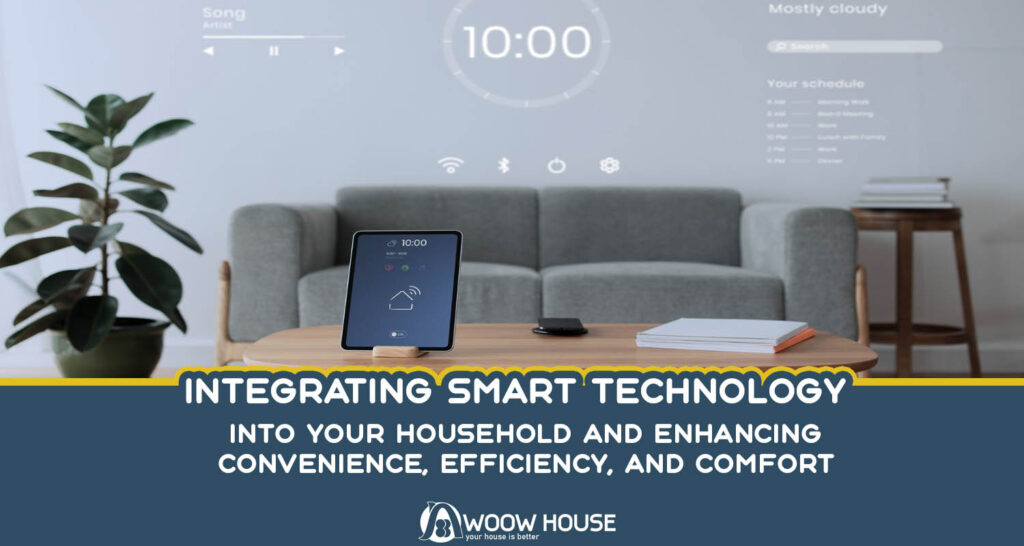In today’s digital age, smart technology has revolutionized the way we interact with our homes, offering unprecedented levels of convenience, efficiency, and comfort. From smart thermostats and lighting systems to connected appliances and security cameras, the possibilities for integrating smart technology into your household are virtually endless. In this essay, we’ll explore the benefits of smart technology, practical considerations for implementation, and tips for maximizing the potential of smart devices to create a connected and intelligent living environment.
Understanding Smart Technology:
Smart technology refers to devices and systems that are equipped with sensors, processors, and wireless connectivity, allowing them to communicate, interact, and be controlled remotely via smartphones, tablets, or voice commands. These devices are designed to automate tasks, monitor conditions, and provide insights to enhance the functionality and convenience of our homes.
Examples of Smart Devices: Smart thermostats, smart lighting systems, smart locks, smart security cameras, smart appliances (such as refrigerators, ovens, and washing machines), smart speakers (such as Amazon Echo or Google Home), and smart home hubs (such as Samsung SmartThings or Apple HomeKit).
Benefits of Smart Technology: Smart technology offers a wide range of benefits for homeowners, including energy savings, enhanced security, improved convenience, and greater control over household systems and appliances. By integrating smart devices into your home, you can streamline routines, optimize resource usage, and create a more comfortable and efficient living environment.
Practical Considerations for Implementation:
Before integrating smart technology into your household, it’s important to consider several practical factors, including compatibility, connectivity, security, and usability. Taking these considerations into account will help ensure a seamless and successful integration of smart devices into your home.
Compatibility: Ensure that the smart devices you choose are compatible with each other and with any existing systems or platforms you may have. Look for devices that support open standards such as Wi-Fi, Zigbee, or Z-Wave, which allow for interoperability and integration with a wide range of devices and platforms.
Connectivity: Reliable internet connectivity is essential for the operation of smart devices, so ensure that your home has a stable and high-speed internet connection. Consider upgrading your router or investing in a mesh Wi-Fi system to ensure strong and consistent coverage throughout your home.
Security: Protecting your privacy and data security is paramount when integrating smart technology into your household. Choose devices from reputable manufacturers that prioritize security and offer features such as encryption, two-factor authentication, and regular software updates. Take steps to secure your home network, such as using strong passwords, enabling network encryption, and keeping firmware up to date.
Usability: Choose smart devices that are intuitive and user-friendly, with simple interfaces and easy-to-use mobile apps or control interfaces. Consider factors such as ease of installation, setup, and configuration when selecting devices, and prioritize devices that offer comprehensive customer support and documentation.
Maximizing the Potential of Smart Devices:
Once you’ve selected and implemented smart devices in your household, there are several strategies for maximizing their potential and getting the most out of your investment. These include optimizing settings, automating routines, integrating devices, and leveraging advanced features and capabilities.
Optimize Settings: Take the time to configure and customize settings for your smart devices to suit your preferences and lifestyle. Adjust temperature thresholds, lighting schedules, and security settings to maximize comfort, energy efficiency, and security.
Automate Routines: Take advantage of automation features to streamline routines and simplify daily tasks. Program smart devices to perform actions automatically based on triggers such as time of day, sensor readings, or user inputs. For example, set your smart thermostat to adjust temperature settings automatically when you leave home or go to bed, or schedule lights to turn on and off at specific times to deter burglars when you’re away.
Integrate Devices: Integrate smart devices into cohesive systems and platforms to enable seamless communication and coordination between devices. Use smart home hubs or platforms such as Apple HomeKit or Google Assistant to centralize control and management of multiple devices and create customized scenes and routines that combine the functionality of different devices.
Explore Advanced Features: Take the time to explore and experiment with the advanced features and capabilities of your smart devices. Many devices offer additional functionality beyond basic controls, such as energy monitoring, occupancy sensing, and voice control. Experiment with voice commands, remote access, and third-party integrations to unlock new possibilities and enhance the functionality of your smart home.
Addressing Concerns and Challenges:
While smart technology offers numerous benefits, it’s important to be aware of potential concerns and challenges associated with its integration into your household. Common concerns include privacy risks, data security, interoperability issues, and technical glitches.
Data Security: Protecting your home network and smart devices from cyber threats is essential for safeguarding your personal information and privacy. Implement strong security practices such as using strong passwords, enabling network encryption, and regularly updating firmware and software to mitigate the risk of unauthorized access and data breaches.
Interoperability Issues: Compatibility issues and interoperability limitations may arise when integrating smart devices from different manufacturers or ecosystems. Research compatibility and interoperability before purchasing devices, and choose devices that support open standards and protocols to facilitate integration and interoperability.
Technical Glitches: Smart technology may be prone to technical glitches, software bugs, and connectivity issues that can disrupt functionality and usability. Stay informed about software updates and patches released by manufacturers, and troubleshoot technical issues promptly to minimize disruptions and ensure smooth operation of your smart devices.
Integrating smart technology into your household offers a wealth of benefits, including convenience, efficiency, and comfort. By considering practical factors such as compatibility, connectivity, security, and usability, homeowners can ensure a seamless and successful integration of smart devices into their homes. By maximizing the potential of smart devices through optimization, automation, integration, and exploration of advanced features, homeowners can create a connected and intelligent living environment that enhances their quality of life.







